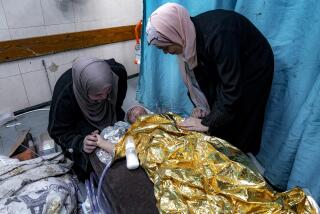82,000 AIDS Orphans Foreseen by Year 2000 : Health: The children will lose their mothers, often the only available care-giver, and that loss could result in a social catastrophe, a study concludes.
- Share via
WASHINGTON — The number of children left motherless by the AIDS epidemic could reach more than 80,000 by the year 2000, resulting in a “social catastrophe” unless measures are taken to address the problem, according to a study released Tuesday.
“Almost unnoticed, the (AIDS) epidemic has been responsible for the creation of a new, large, and especially vulnerable group of motherless youth,” New York researchers reported in the Journal of the American Medical Assn.
“The (AIDS) epidemic has come to rival or surpass other important causes of death in taking the lives of mothers of young children,” they added.
David Michaels of the City University of New York Medical School and Carol Levine, executive director of The Orphan Project, which is administered by the Fund for the City of New York, used a mathematical model to project that about 82,000 youngsters will be “orphaned” by AIDS. Quite often in these cases, the mother is the only available care-giver, so her loss leaves the child orphaned. Many of these women were infected through intravenous drug use or sexually through a drug-using partner.
It is believed to be the first time such comprehensive estimates have been made since the epidemic began in 1981.
“The emergence of a new group of motherless youth because of that disease may . . . be without precedent,” the authors wrote. “Unless increased attention and resources are devoted to this vulnerable population, a social catastrophe is unavoidable.”
Dr. June Osborn, chairwoman of the National Commission on AIDS, has warned about this problem numerous times and said she was not surprised by the projections.
“This aspect of the AIDS tragedy has been looming ever since the beginning,” she said. “For every infant infected at or before the time of birth, two others will themselves be uninfected--but their mothers face a deadly future. And older siblings born prior to the maternal infection are also at risk” of being left without a mother.
This situation, Osborn added, “has been proved many thousands of times in Africa already--the estimate of orphans there is already 1 million. It has been a stunning part of the AIDS epidemic in America, especially along the East Coast, where women of child-bearing age have been involved in substantial numbers since the onset.”
The New York researchers based their projections on a mathematical model that applied cumulative fertility rates to the number of reported AIDS deaths between 1981 and 1990, and AIDS deaths that have been projected for the future of adult women younger than 50.
By the end of 1991, an estimated 18,500 children and adolescents had been left motherless by AIDS, the researchers said. By the end of 1995, that number will grow to 14,600 children and 21,000 adolescents--a total of 35,600, they said.
Unless the course of the epidemic changes drastically, the overall number of children and adolescents left motherless by AIDS by the year 2000 will reach 82,000, they said.
In 1991, an estimated 13% of children and 9% of adolescents whose mothers had died had lost them to AIDS. These statistics will exceed 17% and 12%, respectively, by 1995, the researchers said.
More than 80% of all youths whose mothers have died of AIDS are children of black or Latino women, they said.
Annually, nearly 13,000 children and adolescents lose mothers under the age of 50 to cancer, and about 5,000 lose them as the result of car accidents, they said.
In contrast, the AIDS-related numbers are expected to be more than 7,000, they said.
“The future is even more ominous, bringing with it a mounting cumulative total of affected youth,” they said. “Not surprisingly, these motherless youth will be concentrated in those urban centers where AIDS and HIV infection are most prevalent. The majority will come from communities of color.”
Levine said that increased resources are desperately needed for services to ease the transition period--usually immediately after the mother’s death--until a child is placed elsewhere and other services are available.
“There is a gap where a child loses benefits that the mother had been receiving, and special help is needed,” she said. “We need to have funds targeted for that period of time, which usually lasts about six months to a year.” Also, she said, “bereavement counseling is also needed--it’s the second-most important need.”
Through 1991, 3,900 children--or 39% of the country’s total--and 3,600 adolescents--or 42% of the total--motherless from AIDS were from New York City, the researchers said.
Levine and Michaels described the New York situation as a “preview” for the rest of the nation. “Because the proportion of AIDS deaths among women is rising even more rapidly elsewhere,” Michaels says, “by 1993, less than one in three” children who have lost their mothers to AIDS will live in New York.
In an accompanying editorial, Drs. Stephen W. Nicholas and Elaine J. Abrams of Harlem Hospital Center called for improved health, social and psychosocial support services to help these children cope, and, in particular, urged that community sources--such as schools, churches, YMCAs, and juvenile justice systems--become more involved.
They also recommended that health professionals discuss future custody plans with all HIV-infected parents, and called upon states to review existing guardianship laws, “many of which leave children in legal limbo” when a parent dies.
“One solution to prevent such limbo is the ‘standby guardianship law’ enacted in New York in 1992, which allows an ill or dying woman to name a guardian for her children prior to mental incapacitation, physical debilitation or death,” they said.
Among other things, they also recommended that special focus be given in existing foster care programs to deal with the needs of uninfected siblings, as well as HIV-infected children.
More to Read
Sign up for Essential California
The most important California stories and recommendations in your inbox every morning.
You may occasionally receive promotional content from the Los Angeles Times.












